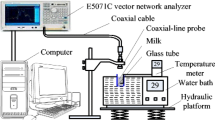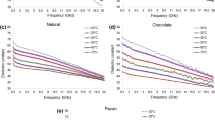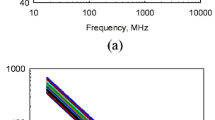Abstract
To understand the effect of protein content on dielectric properties (dielectric constant ε ′ and dielectric loss factor ε ″) of raw milk and to provide information for developing protein content detector being suitable for routine laboratory analysis or real-time quality monitoring, the values of ε ′ and ε ″ of raw cow’s milk with the protein content of 3.21–7.12 % were measured over the frequency range from 10 to 4500 MHz at temperatures from 25 to 75 °C by using a vector network analyzer and an open-ended coaxial-line probe. The results showed that the ε ′ decreased with increasing either frequency or temperature. ε ″ decreased linearly with frequency in a log-log plot at low frequency end and had minimums at about 2000–3500 MHz. The minimums increased with temperature. Below about 600 MHz, ε ″ increased with increasing temperature and decreased above 1000 MHz. ε ′ increased linearly with an increase of protein content below about 150 MHz and decreased linearly above 600 MHz, and ε ″ increased linearly with increasing protein content over full investigated frequency range. The developed third-order polynomial models could describe the dielectric properties of raw cow’s milk as functions of protein content and temperature at a given frequency exactly. If the dielectric properties and temperature of milk can be obtained, its protein content could be sensed.








Similar content being viewed by others
References
Agilent Technologies. (2005). Application note: basics of measuring the dielectric properties of materials, Agilent literature number 5989-2589EN.
Ahmed, J., Ramaswamy, H. S., & Raghavan, G. S. V. (2008). Dielectric properties of soybean protein isolate dispersions as a function of concentration, temperature and pH. LWT - Food Science and Technology, 41(1), 71–81.
Bogomolov, A., Dietrich, S., Boldrini, B., & Kessler, R. W. (2012). Quantitative determination of fat and total protein in milk based on visible light scatter. Food Chemistry, 134(1), 412–418.
Bogomolov, A., & Melenteva, A. (2013). Scatter-based quantitative spectroscopic analysis of milk fat and total protein in the region 400–1100 nm in the presence of fat globule size variability. Chemometrics and Intelligent Laboratory Systems, 126, 129–139.
Bonfatti, V., Di Martino, G., & Carnier, P. (2011). Effectiveness of mid-infrared spectroscopy for the prediction of detailed protein composition and contents of protein genetic variants of individual milk of Simmental cows. Journal of Dairy Science, 94(12), 5776–5785.
Botaro, B. G., Cortinhas, C. S., Mestieri, L., Machado, P. F., & dos Santos, M. V. (2011). Prediction of bovine milk true protein content by mid-infrared spectroscopy. Ciencia Rural, 41(8), 1472–1474.
Coronel, P., Simunovic, J., & Sandeep, K. P. (2003). Temperature profiles within milk after heating in a continuous-flow tubular microwave system operating at 915 MHz. Journal of Food Science, 68(6), 1976–1981.
Cozzolino, R., Passalacqua, S., Salemi, S., & Garozzo, D. (2002). Identification of adulteration in water buffalo mozzarella and in ewe cheese by using whey proteins as biomarkers and matrix-assisted laser desorption/ionization mass spectrometry. Journal of Mass Spectrometry, 37(9), 985–991.
Dziuba, J., Nalecz, D., & Minkiewicz, P. (2001). Reversed-phase high-performance liquid chromatography on-line with the second and fourth derivative ultraviolet spectroscopy as a tool for identification of milk proteins. Analytica Chimica Acta, 449(1–2), 243–252.
Fagan, C. C., Everard, C., O’Donnell, C. P., Downey, G., & O’Callaghan, D. J. (2005). Prediction of inorganic salt and moisture content of process cheese using dielectric spectroscopy. International Journal of Food Properties, 18(3), 543–557.
Feng, X.-d., Su, R., Xu, N., Wang, X.-h., Yu, A.-m., Zhang, H.-q., & Cao, Y.-b. (2013). Portable analyzer for rapid analysis of total protein, fat and lactose contents in raw milk measured by non-dispersive short-wave near-infrared spectrometry. Chemical Research in Chinese Universities, 29(1), 15–19.
García, A., Torres, J. L., Prieto, E., & De Blas, M. (2001). Dielectric properties of grape juice at 0.2 and 3 GHz. Journal of Food Engineering, 48(3), 203–211.
Gunasekaran, N., Mallikarjunan, P., Eifert, J., & Sumner, S. (2005). Effect of fat content and temperature on dielectric properties of ground beef. Transactions of the ASAE, 48(2), 673–680.
Guo, W., Liu, Y., Zhu, X., & Wang, S. (2011a). Dielectric properties of honey adulterated with sucrose syrup. Journal of Food Engineering, 107(1), 1–7.
Guo, W., Nelson, S. O., Trabelsi, S., & Kays, S. J. (2007). Dielectric properties of honeydew melons and correlation with quality. Journal of Microwave Power & Electromagnetic Energy, 41(2), 44–54.
Guo, W., & Zhu, X. (2014). Dielectric properties of red pepper powder related to radiofrequency and microwave drying. Food and Bioprocess Technology, 7(12), 3591–3601.
Guo, W., Zhu, X., Liu, H., Yue, R., & Wang, S. (2010a). Effects of milk concentration and freshness on microwave dielectric properties. Journal of Food Engineering, 99(2), 344–350.
Guo, W., Zhu, X., Liu, Y., & Zhuang, H. (2010b). Sugar and water contents of honey with dielectric property sensing. Journal of Food Engineering, 97(2), 275–281.
Guo, W., Zhu, X., Nelson, S. O., Yue, R., Liu, H., & Liu, Y. (2011b). Maturity effects on dielectric properties of apples from 10 to 4500 MHz. LWT - Food Science and Technology, 44(1), 224–230.
Kalinin, A., Krasheninnikov, V., Sadovskiy, S., & Yurova, E. (2013). Determining the composition of proteins in milk using a portable near infrared spectrometer. Journal of Near Infrared Spectroscopy, 21(5), 409–415.
Mudgett, R. E., Smith, A. C., Wang, D. I. C., & Goldblith, S. A. (1974). Prediction of dielectric properties in nonfat milk at frequencies and temperatures of interest in microwave processing. Journal of Food Science, 39(1), 52–54.
Nelson, S. O. (2003). Frequency- and temperature-dependent permittivities of fresh fruits and vegetables from 0.01 to 1.8 GHz. Transactions of the ASAE, 46(2), 567–574.
Nelson, S. O., & Datta, A. K. (2001). Dielectric properties of food materials and electric field interactions. In A. K. Datta & R. C. Anantheswaran (Eds.), Handbook of microwave technology for food applications (pp. 70–75). New York: Marcel Dekker.
Nunes, A. C., Bohigas, X., & Tejada, J. (2006). Dielectric study of milk for frequencies between 1 and 20 GHz. Journal of Food Engineering, 76(2), 250–255.
Pritchard, S. R., & Kailasapathy, K. (2011). Chemical, physical, and functional characteristics of dairy ingredients. In R. C. Chandan & A. Kilara (Eds.), Dairy ingredients for food processing (pp. 35–57). Ames: Blackwell Publishing Ltd.
Rukke, E. O., Olsen, E. F., Devold, T., Vegarud, G., & Isaksson, T. (2010). Technical note: comparing calibration methods for determination of protein in goat milk by ultraviolet spectroscopy. Journal of Dairy Science, 93(7), 2922–2925.
Rutten, M. J. M., Bovenhuis, H., Heck, J. M. L., & van Arendonk, J. A. M. (2011). Predicting bovine milk protein composition based on Fourier transform infrared spectra. Journal of Dairy Science, 94(11), 5683–5690.
Ryynänen, S. (1995). The electromagnetic properties of food materials: a review of the basic principles. Journal of Food Engineering, 26(4), 409–429.
Sadat, A., Mustajab, P., & Khan, I. A. (2006). Determining the adulteration of natural milk with synthetic milk using ac conductance measurement. Journal of Food Engineering, 77(3), 472–477.
Sipahioglu, O., & Barringer, S. A. (2003). Dielectric properties of vegetables and fruits as a function of temperature, ash, and moisture content. Journal of Food Science, 68(1), 234–239.
Sipahioglu, O., Barringer, S. A., Taub, I., & Prakash, A. (2003). Modeling the dielectric properties of ham as a function of temperature and composition. Journal of Food Science, 68(3), 904–909.
Tang, J., Feng, H., & Lau, M. (2002). Microwave heating in food processing. In X. Young, J. Tang, C. Zhang, & W. Xin (Eds.), Advances in agricultural engineering. New York: Scientific Press.
Wang, J., Tang, J. M., Wang, Y. F., & Swanson, B. (2009). Dielectric properties of egg whites and whole eggs as influenced by thermal treatments. LWT - Food Science and Technology, 42(7), 1204–1212.
Wang, Y., Tang, J., Rasco, B., Kong, F., & Wang, S. (2008). Dielectric properties of salmon fillets as a function of temperature and composition. Journal of Food Engineering, 87, 236–246.
Wang, Y., Zhang, L., Gao, M., Tang, J., & Wang, S. (2013). Temperature- and moisture-dependent dielectric properties of macadamia nut kernels. Food and Bioprocess Technology, 6(8), 2165–2176.
Xin, Q., Zhi Ling, H., Jian Long, T., & Zhu, Y. (2006). The rapid determination of fat and protein content in fresh raw milk using the laser light scattering technology. Optics and Lasers in Engineering, 44(8), 858–869.
Zhang, L., Lyng, J. G., & Brunton, N. P. (2007). The effect of fat, water and salt on the thermal and dielectric properties of meat batter and its temperature following microwave or radio frequency heating. Journal of Food Engineering, 80(1), 142–151.
Zhu, X., Guo, W., & Jia, Y. (2014). Temperature-dependent dielectric properties of raw cow’s and goat’s milk from 10 to 4,500 MHz relevant to radio-frequency and microwave pasteurization process. Food and Bioprocess Technology, 7(6), 1830–1839.
Zhu, X., Guo, W., & Wu, X. (2012). Frequency- and temperature-dependent dielectric properties of fruit juices associated with pasteurization by dielectric heating. Journal of Food Engineering, 109(2), 258–266.
Acknowledgments
This research work was sponsored by grant from Chinese Universities Scientific Fund (No. ZD2012017, Northwest A&F University).
Author information
Authors and Affiliations
Corresponding author
Rights and permissions
About this article
Cite this article
Zhu, X., Guo, W., Jia, Y. et al. Dielectric Properties of Raw Milk as Functions of Protein Content and Temperature. Food Bioprocess Technol 8, 670–680 (2015). https://doi.org/10.1007/s11947-014-1440-5
Received:
Accepted:
Published:
Issue Date:
DOI: https://doi.org/10.1007/s11947-014-1440-5




